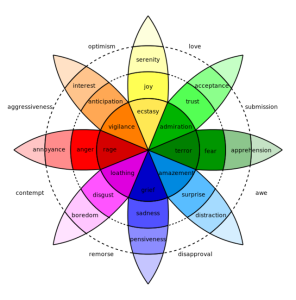React or Respond
React or respond, that is the question! Well... I am clear that, most likely, you are familiar with the original version "To be or not to be... that is the question". However today, if I may, I would like to take the liberty of using a somewhat mundane version related to Mr. William Shakespeare's profound intellectual challenge, which, in my opinion, also deserves a lot of thought and attention.
Why is it that sometimes we feel that an emotion can take over our lives in a way such that it inhibits our ability to think, affects our behavior and even our body functions?
So, the aim of this short article would be that of trying to shed some light on how to manage our emotions in that never-ending internal dispute relative to how we react and/or respond to internal and/or external stimuli.
The basics
Why is it that sometimes we feel that emotions take control of our lives, somehow hijacking our ability to think, affecting our behavior and even impacting our body functions? It is well known that science associates the human being to an engine with complex systems and individual parts that are permanently linked to, and affect, one another. In other words, the physical (i.e. the ‘mechanics’) as well as the mental, emotional and spiritual aspects are not only closely interconnected but are also in constant communication, regulating themselves and each other.
The Dr. Christina Northrup (MD, obstetrician-gynecologist, founder and president of The Center for Women’s Empowerment) suggests that the connection between our emotions and health condition is direct and powerful. So, for example, the part of the brain that allows us to experience them has rich and complex connections with our internal organs, such as the heart and the cardiovascular system.
There is a lot to say about emotions. However, for the sake of keeping this article relatively short, I will mention just few thoughts.
Understanding ‘emotion’
The more we learn about emotions and how they work, the better prepared we are to experience richer and fulfilling lives. Emotions constitute a kind of ‘universal language’ that binds humanity together into a single family. Although these are complex traits, they are nonetheless vital for our survival.

We are all familiar with those situations where overpowering emotions prevent us from listening, thinking and even acting in a judicious manner or, conversely, the lack of them result in a cold and indifferent attitude. Have you heard of Mr. Spock and Data from Star Trek (TV series and movies)? These characters represent clear examples of individuals that are neither able to experience emotions or empathize with others, a condition that generates incomplete and frustrating relationships for the human counterpart. As we can see, the two far ends of the emotional spectrum are 'unhealthy'.
Creating and maintaining a reasonable balance seem more wholesome, where emotions give us the ability to see and think better, and to enable us to feel more alive.
The Basic Emotions
Paul Ekman and Wallace V. Friesen believe that the existence of basic emotions is universal and innate, automatic and quick, and they trigger behaviour with high survival value. It is as if these emotions are hard-wired into the human brain. Although researchers have analysed many more (which can be seen represented in the wheel diagram of emotions), there seems to be a consensus that six basic emotions, i.e, anger, displeasure, fear, happiness, sadness and surprise.
Knowing how to deal with emotions is a valuable talent which some have called emotional intelligence.
Emotions exist to be experienced, worked though and released, but not to be repressed. It is an illusion to think that because we ‘buried or denied’ them they cease to exist. On the contrary, unresolved emotions can become toxic. They will, inexorably, come out sooner or later, in one way or another (e.g. overreacting in an argument, feeling intensely about a particular situation or having difficulties relating to others).
Emotions need to flow like a river. We need to let them run through us. If we hold on to, or accumulate them in our minds, they may have the same effect as a pond with stagnated water that grow bacteria and end up being unhealthy to drink from. Using this analogy, try to visualize something similar happening within you. Not a nice picture, is it? Again, and as I indicated at the beginning of this article, our systems (as human beings) are all connected. Therefore, keeping negative emotions trapped in your ‘internal world’ or being unwilling to let them go is most likely to set a harmful biochemistry in our body.
React or respond
Now that we are back to the main question, what about trying to do a free association exercise?

Reacting to a challenging experience usually means that we adopt an immediate, spontaneous, defensive and/or aggressive attitude. We can feel the tension…. Since our behavior is instinctive, emotionally driven, and oftentimes with a good dose of loss of control, we are perceived by others as the ‘aggressor’.
Responding to a challenging experience means adopting a calm, non-threatening or contained reasoning that invites dialogue.
There is a balance between reasoning and emotions. Of course, responding definitely requires more effort and determination than just letting go off the pressure.
Dealing with challenging experiences
Conscious of the fact that there are many others, I am inclined to suggest the following two mechanisms that may help you to develop, or to continue working on, a set of skills to use whenever you are confronted to a challenging experience.
Using the brain
Rather than referring to emotions as good or bad, I guess that it would make more sense to consider these as a ‘guiding system’. In general, emotions that make us feel good tend to lead us towards a healthier life, while the ones that make us feel bad, uneasy or uncomfortable tend to call our attention relative to the need to refocus, change our perception and/or behavior. In order to make this ‘guiding system’ work, we first need to be able to identify the emotions we are experiencing.
So, let’s say that you are experiencing an overwhelming feeling of sadness. It is clear that the natural tendency is that of being taken over by it, i.e., react. On the other hand, let's think about what would happen if you had a different approach to dealing with it. In other words, 'give it a name'. Eventually you can stop you, o take a break and determine what type of emotion you are facing. For example, in this case, saying to yourself 'I feel sad'.
Make the effort to let the emotion be felt in full, let it flow through you, stay with it and then express it, rather than resist, fix or change it. Take the time to write about what you experienced describing it in as much detail as you possibly can. This exercise will allow you to be able to go over your written notes (no what you remember of it) as many times as you want or need.
Give it a Try
With your notes at hand, you may want to re-read what you wrote. It is quite likely that you will want to ask yourself the kind of questions that may seem difficult to answer, like ‘why am I sad?’, ‘what do I mean by being sad in this particular situation?’, ‘does this sadness only relate to this particular situation or does it also hinge back to a past experience, an old belief or pain?’, ‘why is it still coming back?’, ‘what is this really telling me?’, ‘what is it that I need to learn from all this?’. As you start realizing that this sadness has different dimensions, the initial overwhelming energy starts shifting, i.e. becoming less intense. This is a good example of how we can respond to an emotion.
Please note that I am not saying that this is an easy process to follow. Furthermore, it also takes a substantial amount of resolve and courage to confront this situation. However, increasing the level our awareness helps us to refocus , thus allowing the process of change to take place.
Using the mind
Try to bring your breathing at a slow and steady pace. In doing so, we provide our body with adequate levels of oxygen required to function at its maximum capacity. It also increases our level of awareness of the thought process related to a specific experience.

Centering our attention on our breathing contributes to become more aware of our body, calming our systems down. As we slowly reach the point where our mind starts ‘clearing up’, we simultaneously start localizing, and paying attention to, where the tension is coming from. Making progress in our ability to remain cool when confronted with stressful situations also improves our attentive listening skills.
All this enables us to respond more thoughtfully, hence fostering a collaborative and productive communication space. Keeping our composure is a sign of emotional strength as we consciously let our emotions flow through our body and let go of the pressure.
In summary
Again, I am not saying that reaching this level of mindfulness is easy. There is no escaping to the fact that we will relapse into reacting in the future. However, being able to reflect afterwards on a given situation as well as on our reaction to it will undoubtedly represent a useful lesson for our ongoing journey of personal growth.
Before closing, I would like to share a specific idea that caught my attention when reading the book ‘On Mental Health’ (Melanie Klein, 1960), and which I feel encapsulates the general sense of this article. There, the author argues that having a balanced state of mind does not mean the avoidance of conflict. Rather, it refers to the capacity to tolerate and deal with strong and painful emotions.
If you would like to learn more about the causes and treatment for improving your self-esteem, or to schedule a free telephone consultation, please send me a message via the contact page.

